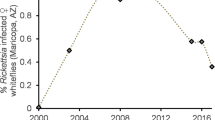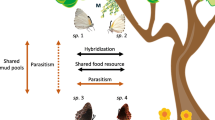Abstract
Many insects harbor facultative microbial symbionts which affect the ecology of their hosts in diverse ways. Most symbionts are transmitted vertically with high fidelity, whereas horizontal transmission occurs rarely. Parasitoid larvae feed on a single host and are in close physical contact with it, providing an ecological opportunity for symbionts’ horizontal transmission, but there is little empirical evidence documenting this. Here we studied horizontal transmission of three bacterial symbionts—Rickettsia, Sodalis, and Wolbachia—between three fly pupal ectoparasitoid species: Spalangia cameroni, S. endius, and Muscidifurax raptor. Muscidifurax raptor readily parasitized and successfully developed on the Spalangia spp., while the inverse did not happen. The two Spalangia spp. attacked each other and conspecifics in very low rates. Symbiont horizontal transmissions followed by stable vertical transmission in the recipient species were achieved, in low percentages, only between conspecifics: Wolbachia from infected to uninfected M. raptor, Rickettsia in S. endius, and Sodalis in S. cameroni. Low frequency of horizontal transmissions occurred in the interspecific combinations, but none of them persisted in the recipient species beyond F4, at most. Our study is one of few to demonstrate symbionts’ horizontal transmission between hosts within the same trophic level and guild and highlights the rarity of such events.




Similar content being viewed by others
Data Availability
N/A
References
Perlmutter JI, Bordenstein SR (2020) Microorganisms in the reproductive tissues of arthropods. Nat Rev Microbiol 18:97–111. https://doi.org/10.1038/s41579-019-0309-z
Russell SL, Chappell L, Sullivan W (2019) A symbiont’s guide to the germline. Curr Top Dev Biol 135:315–351. https://doi.org/10.1016/BS.CTDB.2019.04.007
Dedeine F, Vavre F, Fleury F, Loppin B, Hochberg ME, Bouletreau M (2001) Removing symbiotic Wolbachia bacteria specifically inhibits oogenesis in a parasitic wasp. Proc Natl Acad Sci U S A 98:6247–6252. https://doi.org/10.1073/pnas.101304298
Oliver KM, Martinez AJ (2014) How resident microbes modulate ecologically-important traits of insects. Curr Opin Insect Sci 4:1–7. https://doi.org/10.1016/j.cois.2014.08.001
Russell SL (2019) Transmission mode is associated with environment type and taxa across bacteria-eukaryote symbioses: a systematic review and meta-analysis. FEMS Microbiol Lett:366. https://doi.org/10.1093/femsle/fnz013
Bright M, Bulgheresi S (2010) A complex journey: transmission of microbial symbionts. Nat Rev Microbiol 8:218–230. https://doi.org/10.1038/nrmicro2262
Chrostek E, Pelz-Stelinski K, Hurst GDD, Hughes GL (2017) Horizontal transmission of intracellular insect symbionts via plants. Front Microbiol 8. https://doi.org/10.3389/fmicb.2017.02237
Faria VG, Paulo TF, Sucena É (2016) Testing cannibalism as a mechanism for horizontal transmission of Wolbachia in Drosophila. Symbiosis 68:79–85. https://doi.org/10.1007/s13199-015-0354-y
Su Q, Hu G, Yun Y, Peng Y (2019) Horizontal transmission of Wolbachia in Hylyphantes graminicola is more likely via intraspecies than interspecies transfer. Symbiosis 79:123–128. https://doi.org/10.1007/s13199-019-00623-5
Vavre F, Fleury F, Lepetit D, Fouillet P, Bouletreau M (1999) Phylogenetic evidence for horizontal transmission of Wolbachia in host-parasitoid associations. Mol Biol Evol 16:1711–1723. https://doi.org/10.1093/oxfordjournals.molbev.a026084
Cordaux R, Michel-Salzat A, Bouchon D (2001) Wolbachia infection in crustaceans: novel hosts and potential routes for horizontal transmission. J Evol Biol 14:237–243. https://doi.org/10.1046/j.1420-9101.2001.00279.x
Qi L-D, Sun J-T, Hong X-Y, Li Y-X (2019) Diversity and phylogenetic analyses reveal horizontal transmission of endosymbionts between whiteflies and their parasitoids. J Econ Entomol 112:894–905. https://doi.org/10.1093/jee/toy367
Werren J, Skinner S, Huger A (1986) Male-killing bacteria in a parasitic wasp. Science 231:990–992. https://doi.org/10.1126/science.3945814
Huigens ME, Luck RF, Klaassen RHG, Maas MFPM, Timmermans MJTN, Stouthamer R (2000) Infectious parthenogenesis. Nature 405:178–179. https://doi.org/10.1038/35012066
Parratt SR, Frost CL, Schenkel MA, Rice A, Hurst GDD, King KC (2016) Superparasitism drives heritable symbiont epidemiology and host sex ratio in a wasp. PLoS Pathog 12:e1005629. https://doi.org/10.1371/journal.ppat.1005629
Huigens ME, de Almeida RP, Boons PAH, Luck RF, Stouthamer R (2004) Natural interspecific and intraspecific horizontal transfer of parthenogenesis-inducing Wolbachia in Trichogramma wasps. Proc R Soc B-Biological Sci 271:509–515
Chiel E, Zchori-Fein E, Inbar M, Gottlieb Y, Adachi-Hagimori T, Kelly SE, Asplen MK, Hunter MS (2009) Almost there: transmission routes of bacterial symbionts between trophic levels. PLoS One 4:e4767 https://doi.org/10.1371/journal.pone.0004767
Duron O, Wilkes TE, Hurst GDD (2010) Interspecific transmission of a male-killing bacterium on an ecological timescale. Ecol Lett 13:1139–1148. https://doi.org/10.1111/j.1461-0248.2010.01502.x
Heath BD, Butcher RDJ, Whitfield WGF, Hubbard SF (1999) Horizontal transfer of Wolbachia between phylogenetically distant insect species by a naturally occurring mechanism. Curr Biol 9:313–316. https://doi.org/10.1038/ismej.2016.164
Ahmed MZ, Li SJ, Xue X, Yin XJ, Ren SX, Jiggins FM, Greeff JM, Qiu BL (2015) The intracellular bacterium Wolbachia uses parasitoid wasps as phoretic vectors for efficient horizontal transmission. PLoS Pathog 11:e1004672. https://doi.org/10.1371/journal.ppat.1004672
Gehrer L, Vorburger C (2012) Parasitoids as vectors of facultative bacterial endosymbionts in aphids. Biol Lett 8:613–615. https://doi.org/10.1098/rsbl.2012.0144
Jaenike J, Polak M, Fiskin A, Helou M, Minhas M (2007) Interspecific transmission of endosymbiotic Spiroplasma by mites. Biol Lett 3:23–25. https://doi.org/10.1098/rsbl.2006.0577
Chiel E, Kuslitzky W (2016) Diversity and abundance of house fly pupal parasitoids in Israel, with first records of two Spalangia species. Environ Entomol 45:283–291. https://doi.org/10.1093/ee/nvv180
Wylie HG, Bouletreau M, David J et al (1971) Observations on intraspecific larval competition in three hymenopterous parasites of fly puparia. Can Entomol 103:137–142. https://doi.org/10.4039/Ent103137-1
Wylie HG (1972) Larval competition among three hymenopterous parasite species on multiparasitized housefly (Diptera) pupae. Can Entomol 104:1181–1190. https://doi.org/10.4039/Ent1041181-8
Propp GD, Morgan PB (1983) Multiparasitism of house fly, Musca domestica L., pupae by Spalangia endius Walker and Muscidifurax raptor Girault and Sanders (Hymenoptera: Pteromalidae). Environ Entomol 12:1232–1238. https://doi.org/10.1093/ee/12.4.1232
Betelman K, Caspi-Fluger A, Shamir M, Chiel E (2017) Identification and characterization of bacterial symbionts in three species of filth fly parasitoids. FEMS Microbiol Ecol 93. https://doi.org/10.1093/femsec/fix107
Kyei-Poku GK, Giladi M, Coghlin P, Mokady O, Zchori-Fein E, Floate KD (2006) Wolbachia in wasps parasitic on filth flies with emphasis on Spalangia cameroni. Entomol Exp Appl 121:123–135
Brown LD, Macaluso KR (2016) Rickettsia felis, an emerging flea-borne rickettsiosis. Curr Trop Med reports 3:27–39. https://doi.org/10.1007/s40475-016-0070-6
Semiatizki A, Weiss B, Bagim S, Rohkin-Shalom S, Kaltenpoth M, Chiel E (2020) Effects, interactions, and localization of Rickettsia and Wolbachia in the house fly parasitoid, Spalangia endius. Microb Ecol 80:1–11. https://doi.org/10.1007/s00248-020-01520-x
Gibson GA (2000) Illustrated key to the native and introduced chalcidoid parasitoids of filth flies in America north of Mexico (Hymenoptera: Chalcidoidea). https://doi.org/10.13140/RG.2.2.19059.32809
Gibson GA (2009) Revision of new world spalangiinae (Hymenoptera: Pteromalidae). Zootaxa 2259:1–159. https://doi.org/10.11646/zootaxa.2259.1.1
Moran NA, McCutcheon JP, Nakabachi A (2008) Genomics and evolution of heritable bacterial symbionts. Annu Rev Genet 42:165–190. https://doi.org/10.1146/annurev.genet.41.110306.130119
Schuler H, Bertheau C, Egan SP, Feder JL, Riegler M, Schlick-Steiner BC, Steiner FM, Johannesen J, Kern P, Tuba K, Lakatos F, Köppler K, Arthofer W, Stauffer C (2013) Evidence for a recent horizontal transmission and spatial spread of Wolbachia from endemic Rhagoletis cerasi (Diptera: Tephritidae) to invasive Rhagoletis cingulata in Europe. Mol Ecol 22:4101–4111. https://doi.org/10.1111/mec.12362
Shaikevich E, Bogacheva A, Rakova V, Ganushkina L, Ilinsky Y (2019) Wolbachia symbionts in mosquitoes: intra- and intersupergroup recombinations, horizontal transmission and evolution. Mol Phylogenet Evol 134:24–34. https://doi.org/10.1016/j.ympev.2019.01.020
Tolley SJA, Nonacs P, Sapountzis P (2019) Wolbachia horizontal transmission events in ants: what do we know and what can we learn? Front Microbiol 10. https://doi.org/10.3389/fmicb.2019.00296
Ahmed MZ, Breinholt JW, Kawahara AY (2016) Evidence for common horizontal transmission of Wolbachia among butterflies and moths. BMC Evol Biol 16:118. https://doi.org/10.1186/s12862-016-0660-x
Bailly-Bechet M, Martins-Simões P, Szöllosi GJ et al (2017) How long does wolbachia remain on board? Mol Biol Evol 34:1183–1193. https://doi.org/10.1093/molbev/msx073
Braig HR, Guzman H, Tesh RB, O’Neill SL (1994) Replacement of the natural Wolbachia symbiont of Drosophila simulans with a mosquito counterpart. Nature 367:453–455. https://doi.org/10.1038/367453a0
Fujii Y, Kageyama D, Hoshizaki S, Ishikawa H, Sasaki T (2001) Transfection of Wolbachia in Lepidoptera: the feminizer of the adzuki bean borer Ostrinia scapulalis causes male killing in the Mediterranean flour moth Ephestia kuehniella. Proc R Soc B-Biological Sci 268:855–859. https://doi.org/10.1098/rspb.2001.1593
Grenier S, Bernard P, Heddi A, Lassabliére F, Jager C, Louis C, Khatchadourian C (1998) Successful horizontal transfer of Wolbachia symbionts between Trichogramma wasps. Proc R Soc Lond Ser B Biol Sci 265:1441–1445. https://doi.org/10.1098/rspb.1998.0455
Xi Z, Khoo CCH, Dobson SL (2006) Interspecific transfer of Wolbachia into the mosquito disease vector Aedes albopictus. Proc R Soc B Biol Sci 273:1317–1322. https://doi.org/10.1098/rspb.2005.3405
McCutcheon JP, Boyd BM, Dale C (2019) The life of an insect endosymbiont from the cradle to the grave. Curr Biol 29:R485–R495. https://doi.org/10.1016/j.cub.2019.03.032
Taylor GP, Coghlin PC, Floate KD, Perlman SJ (2011) The host range of the male-killing symbiont Arsenophonus nasoniae in filth fly parasitioids. J Invertebr Pathol 106:371–379. https://doi.org/10.1016/j.jip.2010.12.004
Nadal-Jimenez P, Griffin JS, Davies L, Frost CL, Marcello M, Hurst GDD (2019) Genetic manipulation allows in vivo tracking of the life cycle of the son-killer symbiont, Arsenophonus nasoniae , and reveals patterns of host invasion, tropism and pathology. Environ Microbiol 21:3172–3182. https://doi.org/10.1111/1462-2920.14724
de Jonge N, Michaelsen TY, Ejbye-Ernst R et al (2020) Housefly (Musca domestica L.) associated microbiota across different life stages. Sci Rep 10. https://doi.org/10.1038/s41598-020-64704-y
Junqueira ACM, Ratan A, Acerbi E, Drautz-Moses DI, Premkrishnan BNV, Costea PI, Linz B, Purbojati RW, Paulo DF, Gaultier NE, Subramanian P, Hasan NA, Colwell RR, Bork P, Azeredo-Espin AML, Bryant DA, Schuster SC (2017) The microbiomes of blowflies and houseflies as bacterial transmission reservoirs. Sci Rep 7:1–15. https://doi.org/10.1038/s41598-017-16353-x
Zhang B, McGraw E, Floate KD, James P, Jorgensen W, Rothwell J (2009) Wolbachia infection in Australasian and North American populations of Haematobia irritans (Diptera: Muscidae). Vet Parasitol 162:350–353. https://doi.org/10.1016/j.vetpar.2009.03.012
Mingchay P, Sai-Ngam A, Phumee A, Bhakdeenuan P, Lorlertthum K, Thavara U, Tawatsin A, Choochote W, Siriyasatien P (2014) Wolbachia supergroups a and B in natural populations of medically important filth flies (Diptera: Muscidae, Calliphoridae, and Sarcophagidae) in Thailand. Southeast Asian J Trop Med Public Health 45:309–318. PMID: 24968670.
Böckmann EA, Tormos J, Beitia F, Fischer K (2012) Offspring production and self-superparasitism in the solitary ectoparasitoid Spalangia cameroni (Hymenoptera: Pteromalidae) in relation to host abundance. Bull Entomol Res 102:131–137. https://doi.org/10.1017/S0007485311000447
Bautista CR, Rodríguez T, Rojas C et al (2018) Molecular detection of Anaplasma marginale in stable flies Stomoxys calcitrans (Diptera: Muscidae) feeding on a tick-free bovine herd. Vet Mex 5:1–7. https://doi.org/10.21753/vmoa.5.1.436
Baldacchino F, Muenworn V, Desquesnes M, Desoli F, Charoenviriyaphap T, Duvallet G (2013) Transmission of pathogens by Stomoxys flies (Diptera, Muscidae): a review. Parasite 20:26. https://doi.org/10.1051/PARASITE/2013026
Acknowledgments
We thank Maya Lapid for the professional processing and arrangement of the figures.
Funding
The study was supported by the Israel Science Foundation, grant # 435/18 to Elad Chiel.
Author information
Authors and Affiliations
Contributions
All authors contributed to the experiments design; NT, ACF, KB, and SRS collected the data; NT, KF, and EC analyzed the data; EC led the writing of the manuscript. All authors contributed critically to the drafts and gave final approval for publication.
Corresponding author
Ethics declarations
Conflict of Interest
The authors declare that they have no conflict of interests.
Ethics Approval
N/A
Consent to Participate
N/A
Consent for Publication
N/A (?)
Code Availability
N/A
Rights and permissions
About this article
Cite this article
Tzuri, N., Caspi-Fluger, A., Betelman, K. et al. Horizontal Transmission of Microbial Symbionts Within a Guild of Fly Parasitoids. Microb Ecol 81, 818–827 (2021). https://doi.org/10.1007/s00248-020-01618-2
Received:
Accepted:
Published:
Issue Date:
DOI: https://doi.org/10.1007/s00248-020-01618-2




